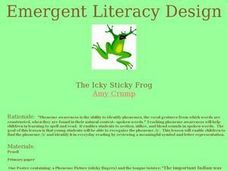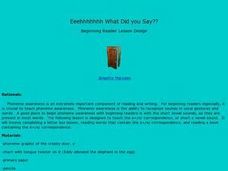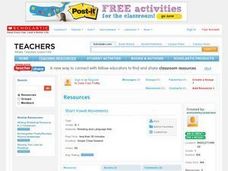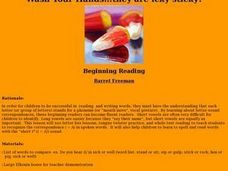Scholastic
Summarizing: Using Hand Motions for Key Words or Points
Learning to summarize texts takes practice. Jump into the training ring and guide your learners through a summarizing practice session. The classic direct instructional practice of "I do, you do, we do" is used to help them identify key...
Curated OER
Vacuuming the V's
Students exercise the skill of phoneme awareness with vocal gestures to create the sound of /v/. They review the way to print the letter "V," how to form the /v/ sound and create a hand gesture to help them recall the vocal gesture of...
Curated OER
The Icky Sticky Frog
Learners practice the strategy of phoneme awareness in order to identify phonemes with vocal gestures in spoken words. They blend letters and sounds together utilizing the phoneme /i/ by symbol and letter representation and listen as the...
ESL Kid Stuff
Wheels on the Bus
Take a trip all around the town! Kids go round and round with a fun set of lessons based on "The Wheels on the Bus." After singing the song together, little learners figure out the hand gestures, reenact the song, and read an...
Curated OER
Thanksgiving
Introduce the basics of Thanksgiving with a language arts instructional activity. As pupils practice observation skills, vocabulary, and reading comprehension, they design paper turkeys by outlining their hands and feet and by...
Curated OER
Hugging, Kissing, and Shaking Hands
In this ESL worksheet, students focus on the appropriate times for hugging, kissing, and shaking hands. Students study the 9 pictures shown and match the occassion with each photo. Students then use the given...
Curated OER
Body Language
The power of signs and signals. Viewers use various body parts to illustrate how gestures convey meaning and how the meaning of these gestures may differ among racial and cultural groups, between men and women, or have meaning to...
Curated OER
Aaaa! It's A!
Exercise phonemic awareness of the vowel /a/ to help children become successful readers. They connect spoken phonemes to written grapheme's and create a relationship between the vocal gesture of /a/ and its grapheme map in text and words.
Curated OER
Icky Fingers
Which i sound is used in the word icky? Kindergarteners and first graders listen to the short /i/ sound. They practice shaking their fingers to indicate icky when they hear the target sound. Then they practice reading a poster with the...
Curated OER
Eeehhhhhhh What Did you Say??
Student read pseudo words containing the e=/e/ correspondence and recognize sounds in vocal gestures and words. They explore the e=/e/ correspondence, or short e vowel sound and complete a letter box lesson plan, reading words that...
Curated OER
"The Scary Letter...aaaaaaaaaa!!!"
Students study the /a/ using the hand gesture and 'aaa' sound as if they were seeing a ghost. Next, they recite a tongue twister and make words using letter boxes using different numbers of phonemes. Next, they read "Pat's Jam" out loud...
Curated OER
Aaaaa! I'm at the Doctor
Students develop Phoneme awareness of a letter. They explore pictures, hand gestures, tongue twisters, and sounding out the letter. The i will be represented through a picture of an i and students circle the words with the...
Curated OER
Short Vowel Movements
Pupils use gestures to recognize the short vowel sounds. In this cvc lesson, students use a cue to recognize the vowel sound. Pupils practice various words with the cues.
ESL Kid Stuff
Telling the Time
What time is it? Language learners are introduced to time vocabulary with a series of activities, songs, and games that let them practice formulating and answer questions about time.
Star Wars in the Classroom
"Shakespeare and Star Wars": Lesson Plan Day 11
Class members take center stage as groups perform scenes from Ian Doescher's William Shakespeare's Star Wars: Verily, A New Hope. Actors are encouraged to add stage directions to the script, as well as create costumes and props to...
Curated OER
Wash Your Hands...they are icky sticky!
Students engage in an emergent literacy lesson that focuses on phonemic awareness and they practice corresponding the letter "i" to its long or short sound. This type of recognition has been found to be essential to reading development.
Curated OER
Moving Lines
Students gain an introduction to gestural line drawing along with art history correlations. They are encouraged to focus on the energy, mass, and expression of the subject rather than on illustrated replication.
Curated OER
Signing a Poem
Young scholars interpret poetry though movement. In this poetry lesson students take a poem they've previously read and discussed in class and work in pairs to develop gestures for each line.
Curated OER
Where Do We Come From? who Are We? Where Are We Going?
Students are responsible for producing works for, coordinating (with the teacher?s assistance) and mounting an exhibition to be presented at a parent-teacher open house. They examine literature by Henry David Thoreau and other writers....
Curated OER
Prospero: Turkey or Tyrant?
Students study characterization and the difference between subjective and objective points of view by creating tableaux to depict three interpretations of the story of Prospero's overthrow, each with a very different point of view. They...
Curated OER
"Icky Bug"
Students study the /i/ sound by examining how one's mouth moves when making the sound and using it in words. Next, they recite a tongue twister which contains many words with the focus sound, and practice writing it the lowercase "i."...
Scholastic
Writing to a Historical Poet
Poetry is a very personal and introspective art form. Give your class the opportunity to understand how a poet's voice can speak to them on a personal level, and that every reader can respond to an author differently. After a poetic...
Curated OER
To Make a Cake you must say /A/
Here is a great way for learners to practice identifying sounds made by both short and long vowels. This lesson stresses the a_e=/A/ correspondence along with letterboxes. They read their spelled words, whole text selection and...
Scholastic
Frindle Lesson Plan
"Who says a pen has to be called a pen? Why not call it a frindle?" Inspired by this quote from the award-winning novel written by Andrew Celements, this lesson allows children to invent their own...























